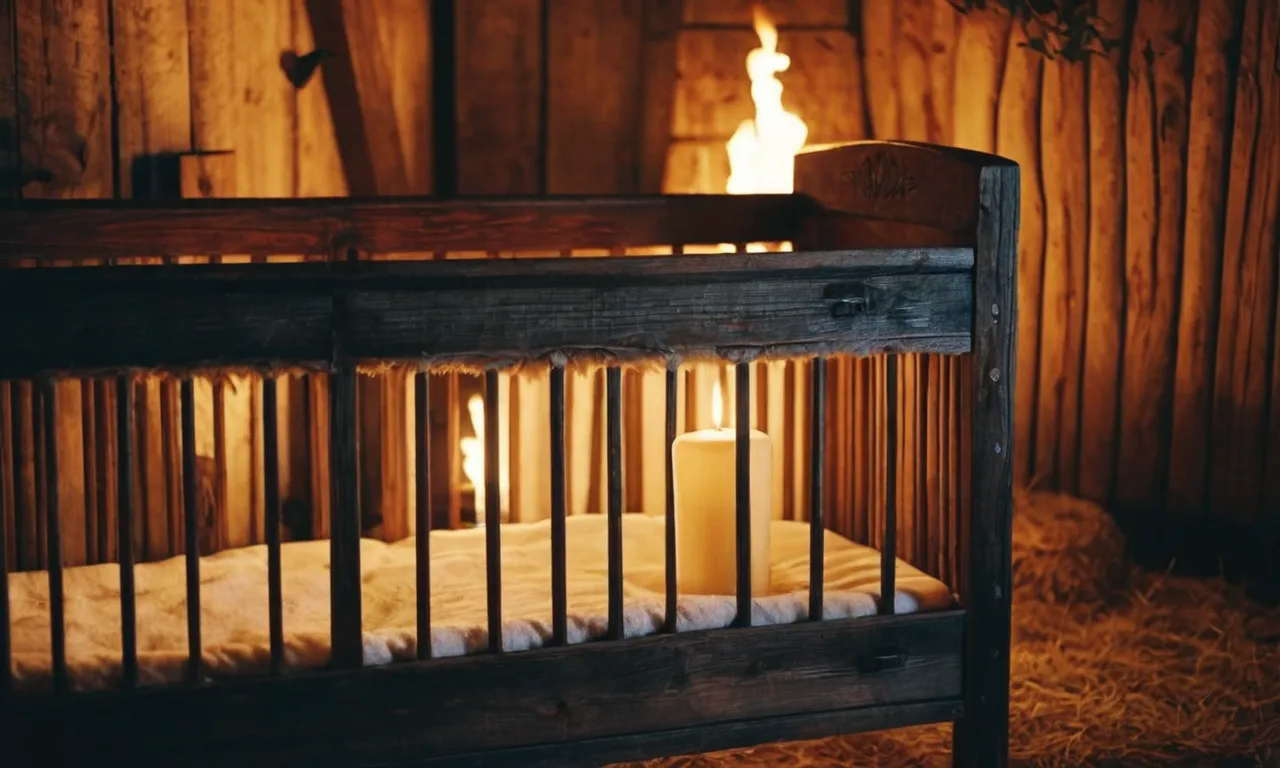The Real Manger Where Jesus Was Born
The story of Jesus’s birth in a humble manger is one of the most iconic images in Christianity. But where exactly was this manger located? If you’re short on time, here’s a quick answer: Most scholars believe Jesus was born in a cave that was used to shelter animals in Bethlehem.
In this article, we will dive deeper into the details around Jesus’s birthplace and what the Bible tells us about the real site of the nativity manger scene.
The Biblical Accounts of Jesus’s Birth
The Gospels of Luke and Matthew
The stories of Jesus’s birth are found in the Gospels of Matthew and Luke. Both describe Jesus being born in Bethlehem, but for different reasons. Matthew’s account centers on the visit of the Magi, while Luke focuses on the census that caused Mary and Joseph to travel from Nazareth to Bethlehem.
In Matthew’s Gospel, Mary and Joseph are living in Bethlehem when Jesus is born. Magi from the east follow a star to Jerusalem looking for the newborn “king of the Jews.” King Herod hears of this and asks the Magi to report back after they find the child.
The Magi follow the star to Bethlehem, where they worship Jesus and give him gifts. They do not report back to Herod, having been warned in a dream. Joseph is warned as well and flees with his family to Egypt to avoid Herod’s wrath before settling in Nazareth.
In Luke’s account, Mary and Joseph live in Nazareth and must travel to Bethlehem for a Roman census. Jesus is born in Bethlehem because there is no room at the inn. Angels appear to shepherds in nearby fields and tell them of the savior’s birth. The shepherds visit the child lying in a manger.
Luke does not mention the Magi but focuses instead on the humble circumstances of Jesus’s birth.
Born in Bethlehem Because of a Census
According to Luke’s Gospel, Jesus was born in Bethlehem because Joseph had to travel there from Nazareth to register for a Roman census. The census, believed to be ordered by Quirinius, governor of Syria, required people to return to their ancestral homes.
For Joseph, this was Bethlehem, the city of David, because he was descended from the house of David.
The exact year this census took place is unclear. It may have occurred around 6-7 CE, shortly before the death of Herod the Great in 4 BCE. Some scholars believe Luke’s account contains historical inaccuracies regarding Quirinius’ governorship and dating of the census.
However, Luke’s narrative emphasizes how God orchestrated events so the prophesies of the messiah being born in Bethlehem would be fulfilled.
No Room at the Inn
The Gospels record that Mary gave birth to Jesus in Bethlehem because there was “no room for them in the inn” (Luke 2:7). This implies that Bethlehem was crowded with other travelers arriving to register for the census.
Jesus was laid in a manger, or feeding trough, perhaps in the lower level of an overflowing inn or possibly in a private home where animals were sheltered.
The traditional image of an inn or hotel with no vacancies is probably incorrect. The Greek word translated as “inn” refers to lodging of any kind. There may have been guest rooms or homes in Bethlehem that simply had no space to accommodate a woman about to give birth.
Regardless, the manger birth powerfully illustrates Jesus’s humble human origins.
Archaeological discoveries in the modern town of Bethlehem have uncovered homes from the 1st century with two levels. The lower level housed animals while the upper level provided space for a family to live. It’s possible such a house could have provided the setting for Jesus’s unusual birthplace.
The Cave Below the Church of the Nativity
Site Historically Associated with Jesus’s Birth
The Church of the Nativity in Bethlehem marks the traditional site where Jesus was born. This sacred site has drawn Christian pilgrims for centuries. Below the church lies a cave that many believe to be the actual location of Jesus’s birth.
Early Christian writers like Justin Martyr and Origen said Jesus was born in a cave. The cave has long been revered as the manger where Mary laid the infant Jesus after his birth. Archeological evidence confirms this cave has been venerated by Christians since the 2nd century AD.
Evidence Supporting the Cave as the Manger Site
There are several reasons why many scholars and pilgrims believe this cave is the real site of Jesus’s nativity:
- The cave has been associated with Jesus’s birth since the early centuries of Christianity. The evidence indicates the cave was identified as the manger site well before the church was built over it.
- The cave matches historical descriptions of Jesus being born in a cave setting, as mentioned by early Christian writers.
- The layout of the cave fits with it being used as a stable in the 1st century. The cave has manger-like troughs carved into the stone walls which could have held hay and animals.
- Archeological excavations found evidence of a 1st century dwelling with a stable directly above this cave, matching the setting for Jesus’s nativity.
While absolute proof is elusive, the collective evidence strongly supports this revered cave as being the actual site where Christ was born in a manger long ago.
Modern-Day Nativity Displays in the Grotto
Today in the underground grotto beneath the Church of the Nativity, elaborate nativity scenes recreate Jesus’s birth. Statues and decorations portray the newborn Jesus resting in the manger, with Mary and Joseph, angels, shepherds, and animals all part of the display.
Twinkling lights and candles illuminate the ornate shrines set up by different Christian denominations. The grotto takes on a magical quality, transporting visitors back in time to imagine the original nativity setting in this place.
While the elaborate decorations are later embellishments, the simple cave itself is the moving spot that potentially witnessed the humble beginnings of the Savior’s life.
Other Proposed Sites for Jesus’s Birthplace
Alternative Caves in Close Proximity
While the Church of the Nativity in Bethlehem marks the traditional spot for Jesus’s birth, some scholars have proposed other nearby locations as possibilities. Several natural caves exist less than five miles from Bethlehem that could have served as a makeshift delivery room for Mary.
One intriguing option is a cave system known as Solomon’s Quarries, located just outside Jerusalem. Ancient legends suggest this site hosted the visiting Magi on their way to see the Christ child. The caves also connect via tunnels to the Second Temple, potentially matching details from early Christian texts.
More archaeological work would be needed to test these alternatives. But their proximity to Bethlehem at least puts them in the running as places mentioned in the nativity story. Christian pilgrims could likely visit multiple candidate sites in a single day to reflect on where the physical evidence best matches the biblical account.
Challenges in Confirming the Exact Location
While the Church of the Nativity enjoys strong historical attestation as Jesus’s birth site, scholars debate whether Christians originally marked the precise spot. Some evidence suggests the basilica simply memorialized the general region where locals believed the event occurred.
More broadly, the lack of contemporaneous documentation from Mary and Joseph’s lifetime means researchers must piece together an imperfect puzzle. The Bible offers only modest biographical details about the couple before or after Jesus’s birth.
And centuries passed before the earliest surviving accounts of travelers visiting Christ’s birthplace.
Given these limitations, historians may never achieve consensus on the exact location. But archaeologists could still uncover more physical or written evidence to favor one site over others. For now, the heart of the nativity narrative—God incarnating as a human to save mankind—remains far more important to Christians than coordinates on a map.
The message of hope and reconciliation rings true regardless of where Mary delivered her special son.
The Meaning Behind the Humble Beginnings
Foretold by Biblical Prophecy
The humble setting of Jesus’ birth fulfilled biblical prophecies about the Messiah. According to the Old Testament, the Messiah would come from an unlikely linage and be born in an unexpected location.
Jesus descended from the line of David and was born in Bethlehem, just as the prophets foretold centuries earlier (Micah 5:2). This showed that Jesus was the fulfillment of God’s promises to send a Savior.
Despite his royal bloodline, Jesus was born into poverty. His family could only afford a manger for his first bed. This humility sent a powerful message that the Messiah came not as an earthly king, but as a humble servant. Jesus left the riches of heaven to meet us in the lowest of circumstances.
He chose an obscure village and a feeding trough to signal that he had come for the poor, broken and marginalized. The Prince of Peace entered the world in meekness.
Signifying Jesus Came for All People
In ancient times, mangers were open to all. Unlike exclusive inns, a manger welcomed both wealthy travelers and common shepherds. By choosing a manger as his first crib, Jesus indicated that he came to redeem people from every walk of life.
Rich and poor, clean and unclean, Jews and Gentiles—all were welcome in the presence of the manger-born Savior.
This universal welcome was driven home when humble shepherds became the first visitors to greet newborn Jesus. In the class-structured societies of the ancient Near East, shepherds occupied the lowest rungs on the social ladder.
Yet God chose these downcast men as the very first eyewitnesses to the Messiah’s birth. Their inclusion proved that Jesus cared for those on the margins.
The magi who arrived later likewise showed that Jesus came for people from all nations. These noble wise men traveled from distant pagan lands to pay homage to the King of kings. From the beginning, Jesus’ incarnation made it clear that God’s love has no bounds.
Anyone who approaches the manger can find the Savior’s welcome embrace.
Conclusion
While we may never know definitively the precise spot where Mary gave birth to Jesus, the traditional site under the Church of the Nativity has a strong claim based on early tradition linking it to Jesus’s birthplace.
More important than the exact physical location is the symbolic meaning behind Christ’s humble beginnings and how it resonates with the core Christian belief that Jesus came for rich and poor alike.








